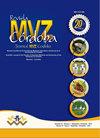Animal welfare assessment on pasture-based dairy farms in Savanna of Bogota, Colombia
IF 0.3
4区 农林科学
Q4 AGRICULTURE, DAIRY & ANIMAL SCIENCE
引用次数: 2
Abstract
Objective. The aim of this study was to determine an overall on-farm animal welfare score (WS) for dairy farms using a protocol involving animal- and management/resource-based variables; and to identify the variables that contributed the most to the variance for the WS. Materials and methods. Twenty-five pasture-based dairy farms in Savanna of Bogota - Colombian high tropic, were visited twice. During each visit, a total of 15 animal- and 13 management/resource-based variables were evaluated. For each variable, a herd-level negative cut-off point was established to determine compliance. Based on compliance, a WS was determined (from 0 to 100) and farms were classified as 'excellent', 'enhanced', 'acceptable', or 'non-acceptable'. A linear regression model was used to evaluate the association between variables at the herd-level with the WS. Results. Overall, median WS was 82 (min=67; max=97). Two farms were classified as 'excellent' (WS=94.5), 20 as 'enhanced' (WS=82.5), and 3 as 'acceptable' (WS=68). Among all variables, the noncompliance regarding subclinical mastitis, hind-legs and udder dirtiness score, ventral line wounds, Haematobia irritans fly counts, and condition/cleanliness of pre-milking holding area was significantly associated with a 5.6, 3.6, 6.7, 5.1, 6.5, and 6.1 points reduction in the WS, respectively (R2=0.84). Conclusions. Welfare level found across farms was good and encouraging. Nonetheless, six variables were identified as the main contributors to an unfavorable result. Strategies for improvement could focus on these variables to be able to reach a welfare level of ‘excellence’.哥伦比亚波哥大萨凡纳牧场奶牛场动物福利评估
客观的本研究的目的是使用涉及动物和管理/资源变量的方案,确定奶牛场的总体农场动物福利评分(WS);并确定对WS的方差贡献最大的变量。材料和方法。在哥伦比亚高热带波哥大的萨凡纳,25个牧场奶牛场被访问了两次。在每次访问期间,共评估了15个动物变量和13个管理/资源变量。对于每个变量,建立一个群体水平的负截止点来确定依从性。根据合规性,确定了WS(从0到100),并将农场分类为“优秀”、“增强”、“可接受”或“不可接受”。使用线性回归模型来评估群体水平的变量与WS之间的关联。结果。总体而言,WS中位数为82(最小值=67;最大值=97)。两个农场被归类为“优秀”(WS=94.5),20个农场被分类为“增强型”(WS=82.5),3个农场被划分为“可接受”(WS=68)。在所有变量中,关于亚临床乳腺炎、后腿和乳房脏度评分、腹线伤口、刺激性嗜血杆菌苍蝇计数和挤奶前保持区的状况/清洁度的不合规性分别与WS降低5.6、3.6、6.7、5.1、6.5和6.1分显著相关(R2=0.84)。结论。农场的福利水平良好,令人鼓舞。尽管如此,六个变量被确定为造成不利结果的主要因素。改善策略可以关注这些变量,以达到“卓越”的福利水平。
本文章由计算机程序翻译,如有差异,请以英文原文为准。
求助全文
约1分钟内获得全文
求助全文
来源期刊

Revista Mvz Cordoba
农林科学-奶制品与动物科学
CiteScore
0.70
自引率
0.00%
发文量
41
审稿时长
6-12 weeks
期刊介绍:
The Journal MVZ Córdoba is an open access international scientific journal financed and edited by the University of Córdoba (Colombia). The journal publishes quarterly, continuously in PDF, XML, Epub, original articles, literature reviews, brief communications and clinical cases, peer-reviewed (double-blind) in Spanish and English, which are related to the agricultural and veterinary sciences. The journal is directed to natural and legal persons of veterinary medicine, animal husbandry, public health, epidemiology, aquaculture, biology, basic biomedical sciences and biotechnology and constitutes a space for academic and scientific discussion around the work of professionals in Veterinary Medicine and Zootechnics. Four-monthly publication.
"The Journal MVZ Córdoba supports the policies for registration of clinical trials of the World Health Organization (WHO) and the International Committee of Medical Journal Editors (ICMJE), since it recognizes the importance of these initiatives for international registration and dissemination. of information about clinical studies, in open access. As a result, since 2007, the journal MVZ Córdoba only publishes clinical research articles that have received an identification number in one of the Clinical Trial Registries validated by the criteria established by WHO and ICMJE, whose addresses are available in the ICMJE website. The identification number is recorded at the end of the summary. "
 求助内容:
求助内容: 应助结果提醒方式:
应助结果提醒方式:


